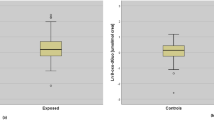Abstract
Objective: This study evaluates whether wood dust and/or wood preservatives develop a carcinogenic potential against the tissues of the airways of rats. Methods: The formation of tumors of the respiratory tract after exposure to wood dust was studied in six groups of approximately 60 female Fischer 344 rats exposed by long-term inhalation to mean concentrations of (1) 18 mg/m3 of untreated oak wood dust, (2) wood preservatives containing ca. 1 μg/m3 lindane and 0.2 μg/m3 of pentachlorophenol (PCP) in the exposure air, or lindane and 18 μg/m3 of PCP (group lindane/PCP vapors, and group oak wood treated with lindane/PCP), (3) 21 or 39 μg/m3 of sodium dichromate (calculated as CrO3, group chromate aerosol and group oak wood with chromate), and 72 μg/m3 of N-nitrosodimethylamine vapors as positive control. The negative control group consisted of 115 animals (sham-exposed). Results: Tumors of the nasal cavity developed in two rats exposed to chromate aerosol or in combination with wood dust (2/102, 2%). Malignant tumors of the lower respiratory tract were induced only in exposed groups of rats (three adenocarcinomas of the lung and four bronchiolar lung carcinomas, 7/254, 2.8%). More respiratory tract tumors were observed in rats exposed to chromate or wood with chromate (5/102, 5%), also in groups exposed to oak wood dust (oak untreated, oak + chromate, oak + lindane/PCP; together 5/155, 3.2%). Analysis of `unpreserved' oak wood dust revealed up to 5 μg/m3 of chromate. When this exposure was taken into account, eight of nine animals with respiratory tract tumors (including nasal cavity) had exposure to chromate, while only one tumor occurred in the group lindane/PCP. Otherwise the incidence of systemic tumors was increased in animals exposed to lindane/PCP, due in particular to a significantly increased incidence of liver tumors (OR=3.7; 1.24–11.3; P=0.019). Fatal (mucoepidermoid) tumors were induced by N-nitrosodimethylamine (NDMA) in the positive control (14/46, 30%). No such tumors of the respiratory tract were observed in the negative control. Conclusions: Tumors in the respiratory tract were found only in exposed animals, predominantly in the groups which inhaled oak wood dust and chromate stain. Chromate may play a decisive role for the etiology of tumors of the nasal cavity in wood workers. This assumption should be supported by further dose-response studies.
Similar content being viewed by others
Author information
Authors and Affiliations
Additional information
Received: 23 May 2000 / Accepted: 13 September 2000
Rights and permissions
About this article
Cite this article
Klein, R., Schmezer, P., Amelung, F. et al. Carcinogenicity assays of wood dust and wood additives in rats exposed by long-term inhalation. Int Arch Occup Environ Health 74, 109–118 (2001). https://doi.org/10.1007/s004200000199
Issue Date:
DOI: https://doi.org/10.1007/s004200000199




